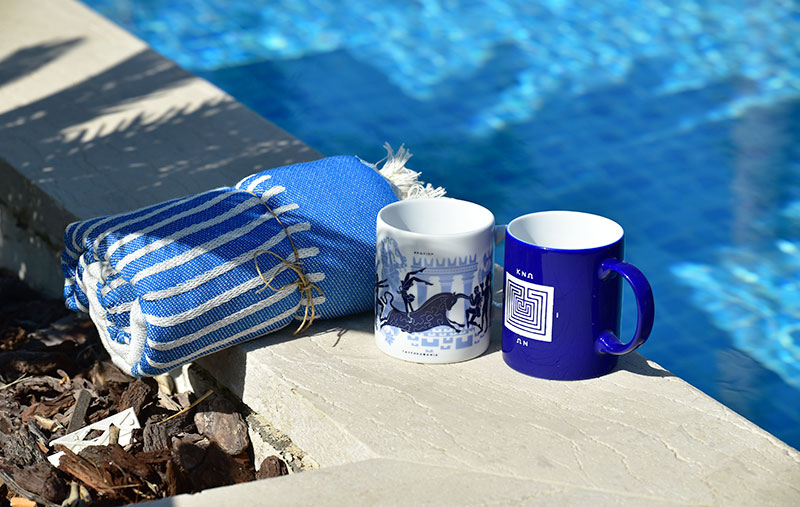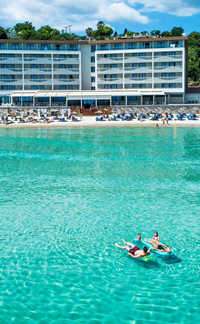Kallithea is in an exceptionally beautiful location about halfway down the eastern side of the westernmost of Halkidiki's 3 legs, Kassandra, about 90km from Thessaloniki. The name gives you a clue to its scenic beauty, because "kalli, ("good")," combined with "thea ("view")," creates a compound word meaning "good view". There are 29 other places named "Kallithea" in Greece, which just helps to prove that this is a country full of good views.
The modern village of about 900 is situated on a low, forested rise of land above the waters of the Toroneaos Bay, which interposes between Kassandra and Sithonia, which is the middle peninsula of Halkidiki. Kallithea was largely settled by Greek refugees from the Pontus region on the Turkish south coast of the Black Sea after the population exchange between Greece and Turkey following the Greco-Turkish war (1919-22). But its history goes much further back than that.
Hotels in Kallithea
Set amongst the olive groves of the eastern shore of Kassandra, the westerly most of the three fingers, Aegean Melathron offers 5-star service for some of the best prices in the region
It is located on the peninsula of Kassandra Chalkidiki and built exactly at the very clean and sandy beach of Kalithea. It is the unique hotel in Chalkidiki which is only one step away from the clear blue sea
The area which now includes Kallithea was originally known as Aphytis. It was a colony that had been settled in the 8th century, BC, by the city-state of Eretria, which was on the island of Evia, about 50km north of Athens. (A massive Persian invasion force had sacked and burned Eretria on its way to meet the Athenian army in the battle of Marathon in 490 BC.)
The Sanctuary of Ammon Zeus
The site of the present day ruins of the Sanctuary of Zeus Ammon, which is close to the seashore, inside the village limits of Kallithea, was originally a cave where Dionysus and the Muses were worshipped in the late 8th century BC. About 400 years later the large temple dedicated to Zeus Ammon was built. It was a Doric peristyle structure, with the original cave in the back of the temple. At about the same time the cult of Asklepios, god of healing, was active in the temple as well. This building was the most famous sanctuary in Halkidiki.
The ruins of the sanctuary were uncovered in 1968 as the result of some illegal building activity taking place in the village. On and off over the following 20 years extensive excavations were carried out.
The historian Xenophon (430-354 BC) writes of a Spartan general wounded in a naval battle across the bay in Toroneaos, Sithonia, who died while being ferried to the sanctuary of Asklepios for healing.
The reason a temple dedicated to Ammon Zeus was built was because the site had abundant water in springs an waterfalls coming from the higher ground around it. Water was an essential element in the worship of Ammon Zeus, a cult with origins in Egypt and Libya. The presence of two rows of column bases, parallel to the temple, which were likely topped by statues, is more in keeping with an Egyptian style of temple construction. The columns created an open-air corridor to one side of the temple.
So 3 deities were worshipped at the site: Dionysus (and the Muses), near the cave (Dionysus was considered the son of Zeus Ammon), Zeus Ammon (who was a horned god), and Asklepios. (The Roman version of Asklepios, Serapis, was also a horned god.)
A Roman bath completed the temple complex about 200 AD, when the sanctuary was reaching its peak as a place of worship.
Ancient Aphytis minted coins which bore the image of Ammon Zeus. Aristotle, who was from Stagira, in northeastern Halkidiki, mentions the agricultural-based economy of Aphytis in a treatise on the public finances in ancient Greece. Greek historian Strabo mentions Aphytis as one of 5 cities in ancient Pallene (now Kassandra) in the 1st century, BC.
The temple was eventually demolished, and a basilica was built over it. In the 11th century, AD a monastery, St. Panteleimon, was built near the ruins of the temple under the auspices of a Russian monastery on Mt. Athos. Some of the old temple's artifacts were carried off to Mt. Athos, where they are still on display. The Archeological Museum in Polygyros, about 50km north of Kallithea, houses part of the roof from the temple.
Sometime later all of the buildings in the vicinity were destroyed, and the settlement was abandoned until it was re-settled by the Asia Minor Greeks in 1922, by which time the temple's foundations had been covered over.
The Modern Resort Village
Probably Kallithea's best feature, apart from the usual sand/sea/nightlife/food combination, is its abundance of greenery, which is unusual for Greece. Those first settlers from Eretria in the 8th century, BC, chose Kallithea for a reason: it was, and is, a well-watered place. It has no harbor to speak of, but water is life, and so the colony was able to thrive, as does the tourist resort and the surrounding agricultural region.
The village boasts a beautiful sandy beach, separated from the village by a road running along the coast at a higher elevation. There are a number of large and small hotels right on the beach. Along the road paralleling the beach there are many clubs and bars, while the village itself is more traditional and quiet. Five minutes north is the even more quiet, traditional village of Afytos, which has a nice folklore museum.
You can buy gold jewelry, furs, shoes and clothing, and the usual tourist things in the village and along the main road. There are also banks, a post office, supermarkets, a clinic, a car rental place and fast food. There is even a go-kart race track if you want to do something a little different.
Kallithea is Halkidiki's most popular destination, and its population explodes during the summer months, not only with tourists, but with city people from Thessaloniki who have holiday homes there. Along the beach are a number of beach bars which are crowded and lively all night long during the summer, featuring bouzouki music, DJs, and dance clubs. Thousands of young day trippers from Thessaloniki descend on Kallithea during the summer months for a night of partying. Kallithea is about a 1.5 hour bus ride from Thessaloniki and all it has to offer. Busses run frequently- about 9 a day, and cost about €10 for a round trip.














